Powering Africa Is the Key to Development


in Guinea reopened its doors on Jan. 19, 2015.
Energy poverty affects more than two thirds of those in sub-Saharan Africa. That is, 600 million that live without access to electricity. In 2013, President Obama launched Power Africa to double access to electricity throughout sub-Saharan Africa.
Electrifying the continent will catalyze development progress. Energy access is intertwined with several development goals such as women’s empowerment, climate mitigation, and expanded education.
Installing solar panels reduces women’s fuel collection time, lowers greenhouse gas emissions, and extends children’s study hours.
The sub-Saharan Africa clean energy market has large investment potential. Nearly 50 percent of new energy production is projected to come from renewable sources through 2040, according to the International Energy Agency.
Power Africa aims to leverage private sector financing for clean energy with funding through the United States and Swedish governments, the African Development Bank, and the World Bank.
In other words, Power Africa funding does not build clean energy projects. Rather, the initiative funds programs that create an enabling environment for private investors.
Tools for Financing
Power Africa offers a suite of tools, known as the Power Africa Toolbox, to its host governments, utilities and companies. The aim of these tools is to de-risk clean-energy investment.
The toolbox has several layers of financial and technical assistance, including:
- Transaction assistance to set up feasibility studies and bring projects to their financial close.
- Financial assistance such as loans and guarantees.
- Policy assistance to host governments, utilities and regulators to create an enabling environment for investment.
- Capacity building for host governments, utilities and regulators through Power Africa advisors and organized trainings.
- Legal assistance to host governments and utilities to structure power deals.
Spotlight on Angola
For Angola, Power Africa’s impacts are expected to be much broader than electricity access.
“The key for Angola’s development is electricity,” said Kiala Pierre, director of the Office of International Exchange at the Ministry of Energy and Water in Angola.
Angola has the third largest gross domestic product (GDP) in sub-Saharan Africa. However, they fall short of several development indicators. Angola’s child and maternal mortality rates are some of the worst in the world and 70 percent of the population lives without access to electricity.

in PPP terms. Source: IMF; IEA analysis, 2014 Africa Energy Outlook.
“Even for those [30 percent of Angolans] who are connected to the grid, inadequate energy supply causes frequent power outages,” Pierre said.
Energy outages negatively impact economic growth, resulting in annual sales losses greater than seven percent.
“We need electricity for every economic activity. When electricity comes to the rural areas, more economic opportunities become locally available,” Pierre said. “For example, with electricity, rural residents can learn to use computers. With access to online weather forecasts, farmers can anticipate rainfall and save water. With online communications, businesses can move to the rural areas.”
Power Africa’s assistance in Angola reduces the costs of doing clean energy business and provides capacity building to the Angolan utility and Ministry of Energy.

Source: World Bank (2015b); IEA analysis, 2014 Africa Energy Outlook.
Previous Power Africa assistance has provided support to the Angolan government and the utility company in the way of feasibility studies. For example, Power Africa implementing partners conducted a cost-reflective tariff study, a transmission modeling study, and a feasibility study to connect the Angolan grid to the South Africa Power Pool.
Power Africa funding for feasibility studies reduces the overall costs of investment as investors typically bear the costs of preliminary assessments.
Now Angola’s Power Africa financing is focused on bringing projects from their feasibility studies to their financial closings. Angola has 800 MW of identified renewable energy projects ready for private investment. Power Africa is expected to place a transaction advisor within the Angolan Ministry of Energy this fall to provide technical advisory, public tender capacity building, and contract negotiation support. The transaction advisory will also liaise with potential investors to identify bankable projects.
As more projects come to financial close, electrification will power the development agenda.
Join our LinkedIn group to discuss this article. You may also email the author directly using our contact form.